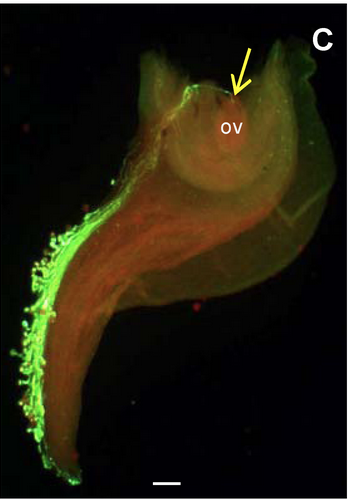Image of the month (April 2015)
Pollen tube growth in cold. Literally cool

The above image shows pollen tube growth in R. glacialis during the cold snap experiment in the laboratory. This image is from an article by Gerlinde Steinacher and Johanna Wagner:
"The Progamic Phase in High-Mountain Plants: From Pollination to Fertilization in the Cold *
Institute of Botany, Faculty of Biology, University of Innsbruck, Sternwartestrasse 15, Innsbruck 6020, Austria
http://www.mdpi.com/2223-7747/2/3/354
Abstract of this paper:
In high-mountains, cold spells can occur at any time during the growing season and plants may be covered with snow for several days. This raises the question to what extent sexual processes are impaired by low temperatures. We tested pollen performance and fertilization capacity of high-mountain species with different elevational distribution in the European Alps (Cerastium uniflorum, Gentianella germanica, Ranunculus glacialis, R. alpestris, Saxifraga bryoides, S. caesia, S. moschata) during simulated cold snaps in the laboratory. Plants were exposed to 0 °C (the temperature below the snow) for 12, 36, 60 and 84 h. In S. caesia, the experiment was verified in situ during a cold snap. Sexual processes coped well with large temperature differences and remained functional at near-freezing temperatures for a few days. During the cooling-down phase a high percentage (67–97%) of pollen grains germinated and grew tubes into the style. At zero degrees, tube growth continued slowly both in the laboratory and in situ below the snow. Fertilization occurred in up to 100% of flowers in the nival species and in G. germanica, but was strongly delayed or absent in the alpine species. During rewarming, fertilization continued. Overall, progamic processes in high-mountain plants appear fairly robust toward weather extremes increasing the probability of successful reproduction.
-----------------------------------------------------------------------------
Click here for previously featured image of the month.
|